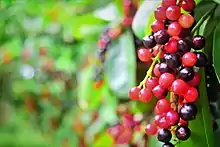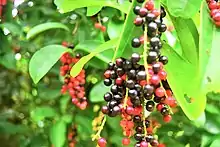Antidesma bunius
Antidesma bunius is a species of fruit tree in the family Phyllanthaceae. It is native to Southeast Asia and northern Australia. Its common Philippine name and other names include bignay,[1] bugnay or bignai, Chinese-laurel,[1] Queensland-cherry,[1] salamander-tree,[1] wild cherry,[1] and currant tree.[1] This is a variable plant which may be short and shrubby or tall and erect, approaching 30 metres in height. It has large oval shaped leathery evergreen leaves up to about 20 cm long and seven wide. They are attached to the twigs of the tree with short petioles, creating a dense canopy.

| Antidesma bunius | |
|---|---|
 | |
| Scientific classification | |
| Kingdom: | Plantae |
| Clade: | Tracheophytes |
| Clade: | Angiosperms |
| Clade: | Eudicots |
| Clade: | Rosids |
| Order: | Malpighiales |
| Family: | Phyllanthaceae |
| Genus: | Antidesma |
| Species: | A. bunius |
| Binomial name | |
| Antidesma bunius | |

The species is dioecious, with male and female flowers growing on separate trees. The flowers have a strong, somewhat unpleasant scent. The staminate flowers are arranged in small bunches and the pistillate flowers grow on long racemes which will become the long strands of fruit. The fruits are spherical and just under a centimetre wide, hanging singly or paired in long, heavy bunches. They are white when immature and gradually turn red, then black.
Each bunch of fruits ripens unevenly, so the fruits in a bunch are all different colors. The skin of the fruit has red juice, while the white pulp has colorless juice. The fruit contains a light-colored seed. The fruit has a sour taste similar to that of the cranberry when immature, and a tart but sweet taste when ripe. This tree is cultivated across its native range and the fruits are most often used for making wine and tea and is also used to make jams and jellies. It is often grown as a backyard fruit tree in Java.
There is an inverse correlation between the ability to taste phenylthiocarbamide and bitterness in A. bunius.[2]
See also
References
- "Antidesma bunius". Germplasm Resources Information Network (GRIN). Agricultural Research Service (ARS), United States Department of Agriculture (USDA). Retrieved 10 January 2018.
- Henkin, R. I.; Gillis, W. T. (10 February 1977). "Divergent taste responsiveness to fruit of the tree Antidesma bunius". Nature. 265 (5594): 536–537. doi:10.1038/265536a0. PMID 834304.